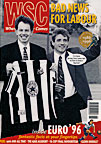 Mike Ticher explains how Glenn Hoddle changed the culture at Chelsea without changing there fortunes
Mike Ticher explains how Glenn Hoddle changed the culture at Chelsea without changing there fortunes
There’s a saying about the underlying sameness of German history, despite all the turmoil on the surface: “It was a very German revolution. That is, not a revolution at all.” In some ways, Glenn Hoddle’s already-mythical reign at Stamford Bridge was a very Chelsea revolution. He has been rightly praised in all quarters for implementing a highly technical, intelligent and aesthetically pleasing style of play. Or, as the Daily Telegraph so graciously put it, for “achieving the monumental feat of educating Chelsea supporters about what constitutes good football”. Yet in terms of consistency and ultimate achievement, it was the same old Chelsea.
In Hoddle’s three seasons in charge they finished fourteenth (after being second bottom at Christmas) eleventh and eleventh, scoring only 145 goals in 122 League games. In the season just ended, they never once strung together more than two consecutive League wins, draws or losses, never climbed higher than eighth or fell lower than 12th after August. True, in his three years in charge Chelsea reached one Cup Final, one semi-final, and a European semi-final – a veritable deluge of excitement after so many barren years. But still nothing to oust the Full Members’ Cup from pride of place in the trophy cabinet.
It’s a pretty mixed record. Certainly not one that would be good enough to get the England job in normal circumstances. But there is more to Hoddle’s time at Chelsea than just the results on the pitch. Other managers in Chelsea’s recent past have produced exciting and distinctive sides, but none could ever be accused of being in the forefront of English tactical thinking.
Take the team built by John Neal, which finished sixth in the League two years in a row in the mid-80s – on the face of it a bigger achievement than anything Hoddle has managed. Neal’s team, perhaps the most fondly-remembered of any since 1970, relied on getting the ball forward quickly for Dixon and Speedie to chase or win in the air. The two workhorses in midfield, Spackman and Bumstead, barely had a creative role, other than to shovel the ball out to Nevin on the wing. The archetypal goal in those days began with a long punt from the keeper or back four, which would be headed on by Speedie for Dixon to chase, miscontrol, bounce the ball off a couple of defenders, stumble, then bundle in through the keeper’s legs off his shin. The amazing thing was, it kept working.
The contrast with Hoddle’s teams couldn’t be greater, despite the continuing presence of the inimitable Nigel Spackman. This season the words “Chelsea” and “beautiful” have been used in the same sentence, with no trace of irony. This is partly why (though the Telegraph wouldn’t credit it) Hoddle has retained the almost universal support of the fans through indifferent League results.
Being able to attract Gullit obviously helped, but it was the intelligent and cultured defending of Chelsea’s own youngsters like David Lee, Andy Myers and Michael Duberry as much as anything which set Hoddle’s teams apart from their predecessors. When Chelsea were promoted in 1984, Neal’s first signing was Doug Rougvie – enough said.
For all the plaudits, Hoddle’s Chelsea team is by no means the finished article. It lacks penetration upfront and, crucially, the ability to increase the tempo when frustrated by good teams. That shows in the identity of Chelsea’s opponents on the only three occasions they came from behind to win in the League this season: Bolton, QPR and Southampton. Stand by for more nil-nil draws against Croatia-like defences at Wembley.
Nevertheless, Hoddle clearly laid the foundations for something good. Whether they can be built on is quite another matter. It would be entirely within character for Chelsea to find an imaginative way to fritter away all the gains of the last three years. The most predictable course would be for Ken Bates to appoint a manager who would be more easily bullied than Hoddle proved to be. His previous choices – John Hollins, Bobby Campbell, Ian Porterfield and (briefly) David Webb – all fell into that category. None had the authority or stature to put a lasting stamp on the club.
Perhaps Bates expected that the relatively inexperienced Hoddle would also be happy to live in his shadow. Thanks to Matthew Harding’s money and his own obvious strength of will, Hoddle was not. At the last game of the season against Blackburn, the Chelsea fans made it clear in anatomically explicit detail that the installation of George Graham would spell the end of any support Bates still retains in what he has accurately described as his “petty, egotistical squabble” with Harding.
With Harding on board, Bates’ usefulness to Chelsea is over (though no-one would deny the massive contribution he made to saving the club in the 1980s). All that’s left is his offensive public posturing. Chelsea fans have drooled over the way Hoddle’s teams have played. But his tenure will only prove to be a real revolution if it marks the beginning of the end for Ken Bates.
From WSC 112 June 1996. What was happening this month